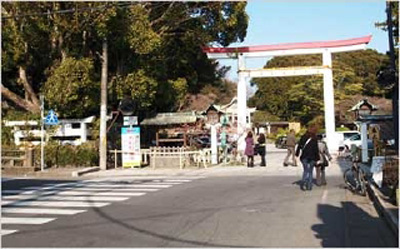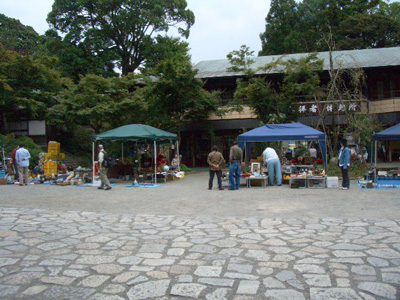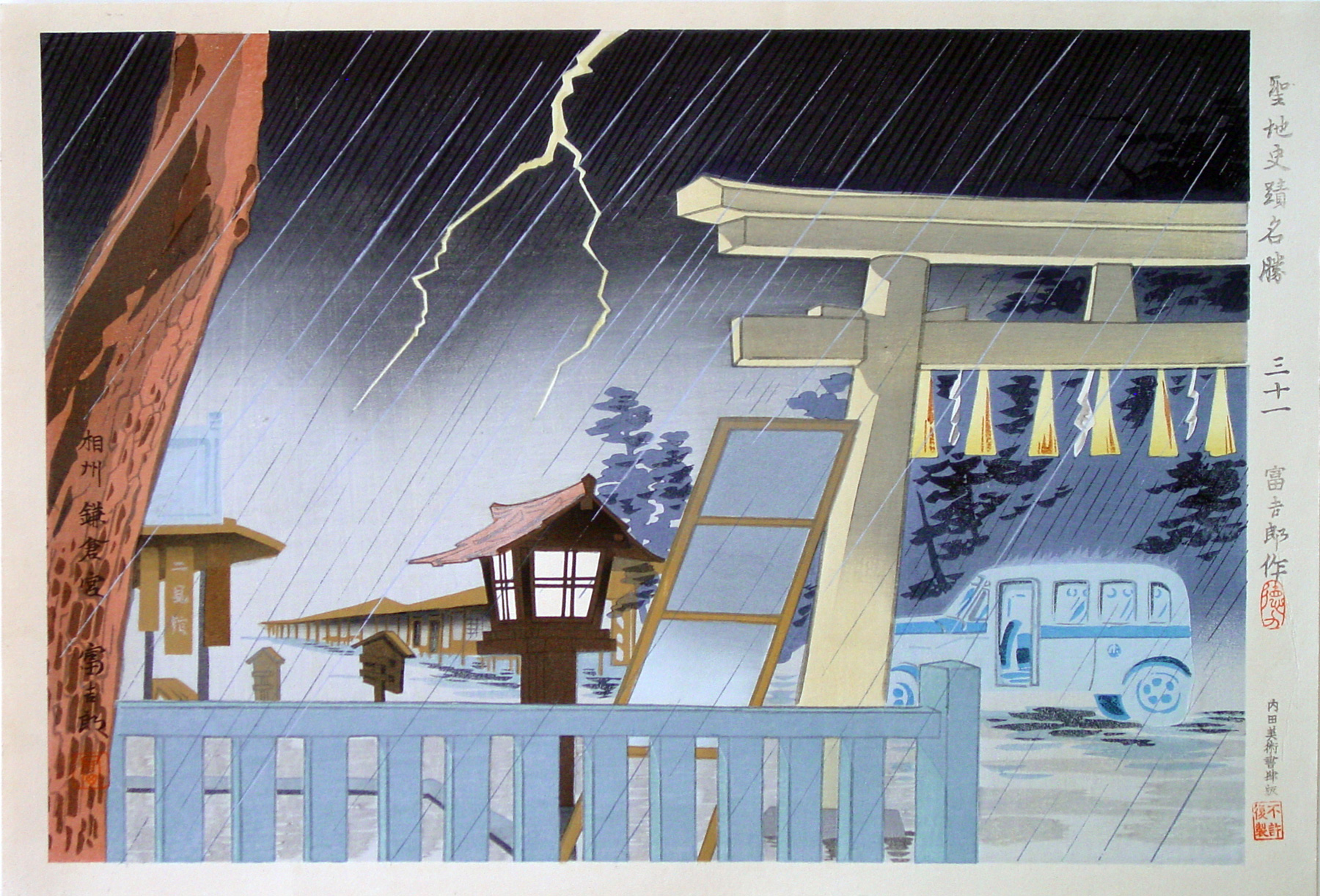About This Print
Print number thirty-one in the fifty print series Scenes of Sacred and Historic Places (Seichi Shiseki Meisho) published by Uchida Woodblock Printing Company in 1941. Tokuriki makes effective use of Hiroshige-style rain and Hokusai-style lightning to portray the grounds of Kamakura-gu during a violent thunderstorm. A bus sits with its door open and a loan shoji sits to the left of the torii, indicating this storm started suddenly sending everyone to shelter.The Series - Scenes of Sacred and Historic Places
The print artist Tokuriki and the publisher Unsōdō created two series of prints to mark Kigen 2600, or the 2600th year of Japan's mythical founding as a nation. The first, a paean to Mount Fuji, a sacred site of pilgrimage and worship, titled Thirty-Six Views of Mount Fuji, harkened back to Hokusai’s famous 1831 series of the same name. The second series, Scenes of Sacred and Historic Places, capitalized on the nationalist ideology that Japan was a divine land, presenting overtly nationalistic landscapes including shrines, temples, castles, places associated with the divine origins of Japan, Meiji era history and samurai
culture.
In his commentary on this series, the artist wrote that his devotion to these sites is intended to demonstrate to the people the dignity of the national polity, going on to say that he advocates prints as a means of providing comfort and pleasure to the wholesome citizens of the nation.
This series was extremely popular with domestic and foreign buyers who purchased one thousand copies within a short time after issuance.1 I imagine that foreign buyers were enchanted by the lovely scenes with much of the import of each print escaping them. In the 1950s, six prints from this series were re-printed under the title The Album of Famous Views of Japan and eight additional prints were re-printed under the title The Eight Views of Japan. Later printings omit the information in the margin and some position the artist's signature and print title within the image in a different location from the original issue.
For images of all the prints in the series, go to the website of Ross Walker's Ohmi Gallery at http://www.ohmigallery.com/Gallery/Tokuriki/SacredPlaces.htm.
1 Modern Japanese Woodblock Prints - The Early Years, Helen Merritt, University of Hawaii Press, 1998, p. 89.
In his commentary on this series, the artist wrote that his devotion to these sites is intended to demonstrate to the people the dignity of the national polity, going on to say that he advocates prints as a means of providing comfort and pleasure to the wholesome citizens of the nation.
For images of all the prints in the series, go to the website of Ross Walker's Ohmi Gallery at http://www.ohmigallery.com/Gallery/Tokuriki/SacredPlaces.htm.
1 Modern Japanese Woodblock Prints - The Early Years, Helen Merritt, University of Hawaii Press, 1998, p. 89.
Margin Annotations of Original Edition (top to bottom) and Print Title Within Image
 series title Seichi Shiseki Meishō 聖地 史蹟 名勝 |  三十一 (31) |  Tomikichiro Saku 富吉郎 作 (Made by Tomikichiro) followed by oval seal1 |  内田美術書肆版 (Uchida Fine Art Shop) followed in seal form by Fukyo Fukusei (Reproduction forbidden)) | Print Title (Kamakura-gu Shrine in Sagami) |
1 possibly a reproduction of an old censor's seal
The title of each print appears within the image area along with the artist's signature and seal. The artist's signature is comprised of the artist's name 富吉郎 (Tomikichirō) either by itself, as shown below, or followed by the single kanji character 作 (saku "made by") or by the character 謹 (kin "respectfully") followed by 作.

Kamakura-gu Shrine
Source: website of Kamakura Citizens Net http://www.kcn-net.org/e_kama_history/nikaido/nikaido.htmThe Shrine, dedicated to Prince Morinaga, was built in 1869 by order of Emperor Meiji (明治天皇, 1852-1912). This is the only shrine ever constructed by imperial order.
Story of Prince Oto no Miya Morinaga
Emperor Meiji was very much moved when he learned of Prince Oto no Miya Morinaga's devotion to the imperial cause and of his tragic death.
Prince Morinaga was the third son of Emperor Go-Daigo (後醍醐天皇). He supported his father and fought bravely when the emperor rose up in 1331 against the Kamakura government. Following his father's success in restoring their rule in 1333, Morinaga was appointed supreme military commander, but soon had a falling out with a powerful supporter, Ashikaga Takauji (足利尊氏). Takauji had Morinaga arrested and exiled to Kamakura. He was confined at Tokoji Temple (東光寺) near the place where the present Kamakuragu Shrine stands.
Meanwhile, Hojo Tokiyuki (北条時行, ?-1353), the second son of Hojo Takatoki (北条高時, 1303-33, the last ruler of the Kamakura bakufu), was waiting for a chance to regain his own rule after the Hojo clan was destroyed. In 1335, Tokiyuki took up arms and marched east to recapture Kamakura. At that time, Kamakura was in the hands of Ashikaga Tadayoshi (足利直義, 1306-52), younger brother of Takauji. Tadayoshi was defeated by Tokiyuki and forced to leave Kamakura. Amid all the confusion, Tadayoshi was unsure about what to do with the prince and, in the end, ordered a subordinate Fuchinobe Yoshihiro (淵辺義博) to kill him. The Prince was 28 at the time.
Grounds and structures
The shrine has three main structures: a haiden, or oratory, a Noritoya (祝詞舎, a hall for ritual prayers offered to a Shinto deity), and the main hall.
To the right of the front hall is a newly created wooden statue of a warrior, Murakami Yoshiteru (村上義光, ?-1333). He fought with Prince Morinaga against the Hojo forces at Mt. Yoshino (吉野山) in Nara. When Morinaga was in danger, Yoshiteru, disguised as the prince Morinaga, fought in his place and met a violent death.
Behind the main hall is an area where some historic monuments are preserved. The first is a cave some four meters square, in which the prince is said to have been confined. Further inside the precincts are tall camphor trees and beside them is a marker called Gokobyo (御構廟), or Okamae-dokoro, which indicates where the prince's executioner, Fuchinobe, threw away the prince's head out of fear the eyes would continue to stare accusingly, even after death.
Nearby are several monuments: a tahoto-type stupa (多宝塔) dedicated to Nikken (日賢) by his disciple, Nichiei (日叡), son of the murdered prince; and a kencha-no-to stone monument (献茶の塔, "Tea-Offering Monument").
 Entrance to Kamakura-gu |  View of interior grounds |
Print Details
| IHL Catalog | #440 |
| Title | Kamakura-gu Shrine in Sagami* 相州鎌倉宮 |
| Series | Scenes of Sacred and Historic Places (also seen translated as "Collected Prints of Sacred, Historic and Scenic Places") 聖地 史蹟 名勝 Seichi Shiseki Meisho |
| Artist | Tokuriki Tomikichirō (1902-2000) |
| Signature | Tomikichirō 富吉郎 |
| Seal |  |
| Date | September 1941 |
| Edition | original (first) edition |
| Publisher | Uchida Bijutsu Shoten |
| Impression | excellent |
| Colors | excellent |
| Condition | excellent - minor residue top corners verso from previous folio mounting |
| Genre | shin hanga (new print); fūkeiga |
| Miscellaneous | 三十一 #31 in series |
| Format | horizontal oban |
| H x W Paper | 11 1/4 x 16 1/2 in. (28.6 x 41.9 cm) |
| H x W Image | 10 1/2 x 15 (26.7 x 38.1 cm) |
| Collections This Print | Penn Libraries, Rare Book & Manuscript Library - Rare Book Collection Call no.: Portfolio NE1325.T65 A4 1940 |
| Reference Literature | |


